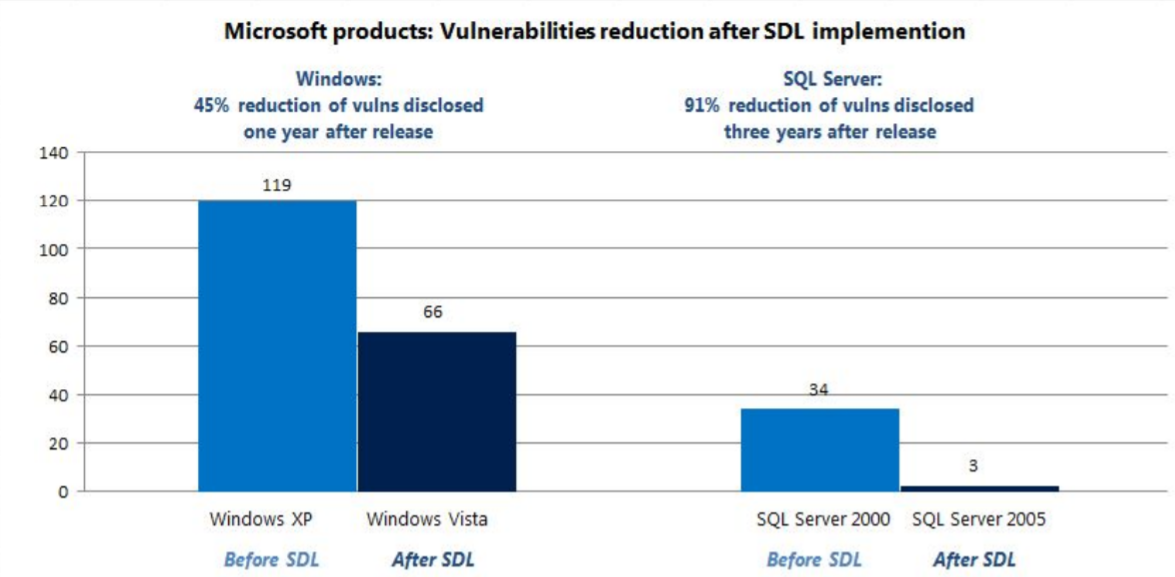Observability and metrics paradox
It is also about observability: ”If a tree falls in a forest and no one is around to hear it, does it make a sound?” …or… What is the return value (in dollars number) of having a better SDL in place if your company wasn’t shaken by cybersecurity incidents? I see a little paradox here, after spending big budget into security you cannot measure the returns, even more, the returns are less visible: you don’t have incidents in the first place…and if they happen then “someone saves you”, you may have prevented 9/10 of incidents but it is difficult to make a counterfactual argument at that point.
Oh yes, if you had big problems in the past you can then see the statistical improvements over time, Microsoft did.
From: https://www.owasp.org/images/9/92/OWASP_SwSec5D_Presentation_-_Oct18.pdf
Microsoft case teaches
Microsoft had a nice market position and did deal with security in the early 2000s. Not any company has a de facto monopoly in the market. Your company has competitors and alternatives, needs reputation…and let’s not dig too deep into cyber-fines scenarios.
MS in the early 2000’s put great efforts in defining and in applying SDL and still nowadays MS SDL is the reference implementation. That was the genesis of SDL as we know it today, practices like STRIDE Threat Modeling are de-facto standards in the industry.
Fortunately, the metrics paradox is getting weakened by the fact that SDL is becoming a value in itself, that can be shown, that completes quality, that enhances reputation, marketing and it is content more than form (not only compliance), we’ll see how security principles are taken over formal compliance checklists.
Dear <big tech firm here>, can I evaluate your Secure Development Lifecycle?
Supply chain customers start to demand secure process itself, not only secure products and certifications (assuming it is even plausible). An example is the case of UK Gov relation with Huawei, but I’m confident others will follow. The next extract is from Huawei cyber security evaluation centre oversight board: annual report 2019
“3.35 …analysed the adherence of the product to part of Huawei’s own secure coding guidelines, namely safe memory handling functions. … analysed for the use … of memcpy()-like, strcpy()-like and sprintf()-like functions in their safe and unsafe variants.”
Not many companies with some complexity and history could quietly survive a similar analysis.
Principles based practices and cyber-environmentally safety requirement
The security demand cannot be met only by compliance requirements, compliance, in its various forms (PCI, ISOXXXX) is still a necessary “sine qua non” condition, but customers and counterparties demand more substance behind that. We can observe this “substance winning over form” for example in GDPR as a principles based regulation, as well as in the demand for security processes results to key vendors (see Huawei report from cybersecurity government agency).
From Wikipedia, GDPR: “Controllers of personal data must put in placeappropriate technical and organisational measures to implement the data protection principles”
With that clear in mind, it doesn’t take too long to forecast that an enterprise investing in security principles and substantial SDL will have a double advantage, the genesis/primordial one: more secure product (e.g. MS 2002) but also the newer one coming for the visibility, that customers demand now more and more.
SDL was a means to have more secure product, today even more, is becoming a company “value” and something in the realm of morality and ethics, not so different from environmental sustainability. Also, the earlier a company is in the supply chain (hardware, operative system, authentication server, payment gateway, dev frameworks) the more it should care as the biggest is the damage they can do to the information technology environment. Latests year’s Spectre, Heartbleed, EternalBlue, BIOS and software update security incidents are just a few examples of polluting the supply chain.
Metrics transformation; lead vs lag indicators
Take this example of metrics
“the percentage of people wearing hard hats on a building site is a leading safety indicator. A lagging indicator is an output measurement, for example; the number of accidents on a building site is a lagging safety indicator.”
From: https://www.intrafocus.com/lead-and-lag-indicators/
As the security development practices evolve, the same should happens to related metrics. Formal compliance frameworks and lack of severe incidents may have been enough in the past, but neither happens before software development itself. On the other hand, leading indicators are measured during the SDL; leading efforts could be measured in both resources expenditures and assessing maturity level, better both.
After all, would you trust a nuclear power plant just because is law compliant and had no incidents in the last 10 years even IF they don’t spend a buck in security? Let’s put it this way: consider that our planes and power plants use a lot of software, as well as our future medical operation machine, human and self driving cars etc… and I want to see organizations passionately investing in security, in the smartest, and more efficient way, please!
In the next part(s) I want to dig deeper into the evolution of SDL practices in the cyber security market.

No comments:
Post a Comment